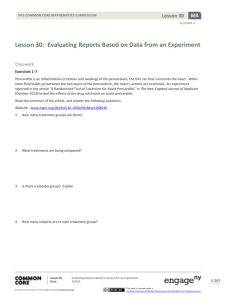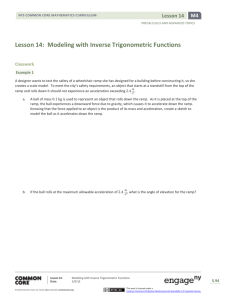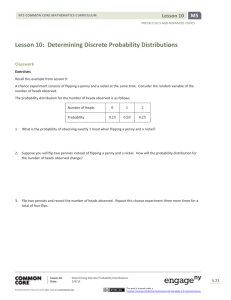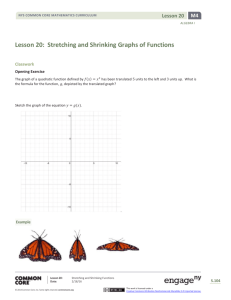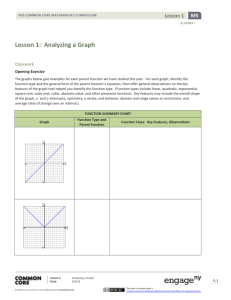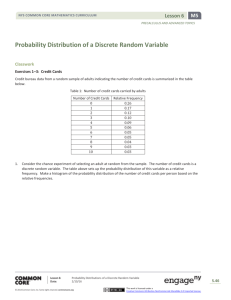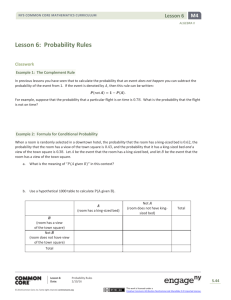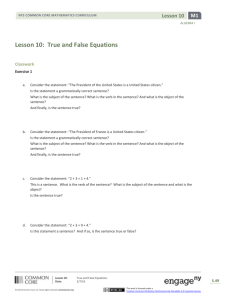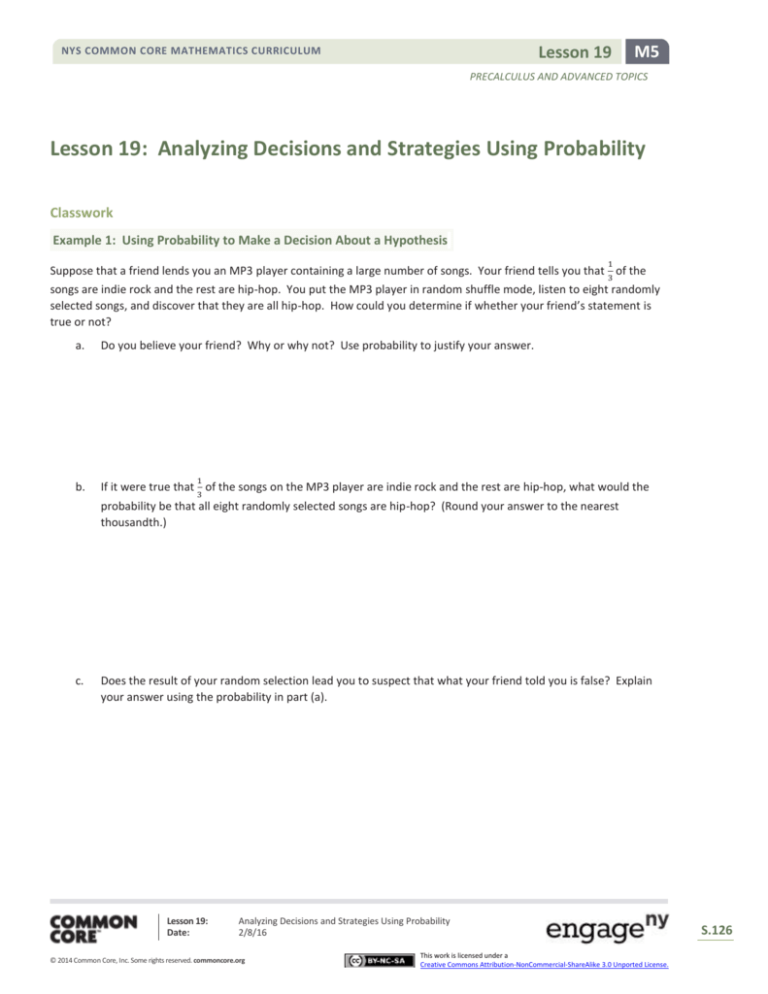
Lesson 19
NYS COMMON CORE MATHEMATICS CURRICULUM
M5
PRECALCULUS AND ADVANCED TOPICS
Lesson 19: Analyzing Decisions and Strategies Using Probability
Classwork
Example 1: Using Probability to Make a Decision About a Hypothesis
1
Suppose that a friend lends you an MP3 player containing a large number of songs. Your friend tells you that of the
3
songs are indie rock and the rest are hip-hop. You put the MP3 player in random shuffle mode, listen to eight randomly
selected songs, and discover that they are all hip-hop. How could you determine if whether your friend’s statement is
true or not?
a.
Do you believe your friend? Why or why not? Use probability to justify your answer.
b.
If it were true that of the songs on the MP3 player are indie rock and the rest are hip-hop, what would the
1
3
probability be that all eight randomly selected songs are hip-hop? (Round your answer to the nearest
thousandth.)
c.
Does the result of your random selection lead you to suspect that what your friend told you is false? Explain
your answer using the probability in part (a).
Lesson 19:
Date:
Analyzing Decisions and Strategies Using Probability
2/8/16
© 2014 Common Core, Inc. Some rights reserved. commoncore.org
This work is licensed under a
Creative Commons Attribution-NonCommercial-ShareAlike 3.0 Unported License.
S.126
Lesson 19
NYS COMMON CORE MATHEMATICS CURRICULUM
M5
PRECALCULUS AND ADVANCED TOPICS
Exercises
1.
2.
A class consists of 12 boys and 12 girls. The teacher picks five students to present their work to the rest of the class
and says that the five students are being selected at random. The students chosen are all girls.
a.
If the teacher were truly selecting the students at random, what would the probability be that all five students
selected are girls? (Round your answer to the nearest thousandth.)
b.
Does the fact that all five students selected are girls lead you to suspect that the teacher was not truly
selecting the students at random but that the teacher had a preference for choosing girls? Explain your
answer using the probability in part (a).
School starts at 8:00 a.m.; it is now 7:30 a.m., and you are still at home. You have to decide whether to leave now
and ride your bicycle to school or to call a friend and ask the friend to pick you up. Your friend would take 10
minutes to get to your house. You know that when you ride your bicycle, the time it takes to get to school has a
mean of 26 minutes and a standard deviation of 3 minutes. When your friend drives you, the time it takes to get
from your home to school has a mean of 14 minutes and standard deviation of 5 minutes. Which of the two
alternatives will make you more likely to get to school on time? Show the assumptions that must be made and the
calculations that lead to your conclusion.
Lesson 19:
Date:
Analyzing Decisions and Strategies Using Probability
2/8/16
© 2014 Common Core, Inc. Some rights reserved. commoncore.org
This work is licensed under a
Creative Commons Attribution-NonCommercial-ShareAlike 3.0 Unported License.
S.127
Lesson 19
NYS COMMON CORE MATHEMATICS CURRICULUM
M5
PRECALCULUS AND ADVANCED TOPICS
3.
4.
Recent polls have shown that 58% of voters in a city support a particular party. However, the party has just entered
a new phase of its campaign, and in a new poll of 1,000 randomly selected voters, the proportion of voters who
support the party is found to be 0.597.
a.
It is known that if 58% of all voters support the party, the proportion of people in a random sample of 1,000
voters who support the party is approximately normally distributed with mean 0.58 and standard deviation
0.0156. If 58% of voters supported the party, what would be the probability of a sample proportion of 0.597
or more supporting the party? (Round your answer to the nearest thousandth.)
b.
Should the result of the new poll lead the party to think that support for the party has increased? Explain your
answer using the probability in part (a).
In order to be admitted to a master’s degree program, Tim must take a graduate record examination. A graduate
record examination is in three sections: verbal reasoning, quantitative reasoning, and analytic writing. The exam is
administered by two different companies. In Company A’s version of the exam, Tim estimates that his probabilities
of passing the three sections are 0.85, 0.95, and 0.90, respectively. In Company B’s version, he estimates the
probabilities of passing to be 0.92, 0.93, and 0.88 for the three sections. (You may assume that, with either of the
companies, Tim’s outcomes for the three sections of the exam are independent.)
a.
Which company should Tim choose if he must pass all three sections?
b.
Which company should Tim choose if he must pass at least one of the sections?
Lesson 19:
Date:
Analyzing Decisions and Strategies Using Probability
2/8/16
© 2014 Common Core, Inc. Some rights reserved. commoncore.org
This work is licensed under a
Creative Commons Attribution-NonCommercial-ShareAlike 3.0 Unported License.
S.128
Lesson 19
NYS COMMON CORE MATHEMATICS CURRICULUM
M5
PRECALCULUS AND ADVANCED TOPICS
Lesson Summary
If a number of strategies are available and the possible outcomes are success and failure, the best strategy is the
one that has the highest probability of success.
Probability can be used to decide if there is evidence against a hypothesis. If, assuming that the hypothesis is true,
the observed outcome is unlikely (probability < 0.05), then there is strong evidence that the hypothesis is false. If
the observed outcome is not particularly unlikely, then there is not strong evidence that the hypothesis is false.
Problem Set
1.
To qualify for a vegetable-growing competition, onions must have a mass of at least 200 g. A grower has the choice
of two different types of onion. The first type (when grown under certain conditions) grows to a mass that is
approximately normally distributed with mean 192 g and standard deviation 15.3 g. The second (grown under the
same conditions) grows to a mass that is approximately normally distributed with mean 187 g and standard
deviation 18.8 g. Which of the two types is more likely to produce an onion that qualifies for the competition?
2.
Ron’s Joke Store sells both regular (fair) number cubes and weighted number cubes. Unfortunately, some of the
number cubes have been mixed up. An employee rolls one of the number cubes 100 times, and the proportion of
these rolls that result in sixes (the sample proportion) is 0.24.
a.
It is known that if a fair number cube is rolled 100 times, then the sample proportion of rolls that result in sixes
1
is approximately normally distributed with mean and standard deviation 0.0373. If the number cube were
6
fair, what would the probability be that the sample proportion in 100 rolls that result in sixes would be at least
0.24? (Round your answer to the nearest thousandth.)
b.
3.
4.
Does the employee’s result provide strong evidence that the number cube is biased toward sixes? Explain
your answer using the probability in part (a).
Alex and Max are twins, and they are both about to take exams in math, English, history, and science. Their parents
have offered them special privileges (details to be announced) if they get A’s in all their exams. For the four exams,
Alex’s probabilities of getting A’s are 0.8, 0.9, 0.8, and 0.95, respectively. The equivalent probabilities for Max are
0.9, 0.9, 0.85, and 0.85. (You can assume that the results of the four tests are independent of one another.)
a.
Which of the twins is more likely to get A’s in all the exams?
b.
Which of the twins is more likely to get at least one A?
Roxy is a statistics teacher. She has a set of 52 cards, and she tells her class that there are 26 red and 26 black
cards. Roxy shuffles the cards and offers cookies to the first student to select a red card. An eager volunteer starts
to select cards at random; after each selection, the card is returned and the cards are shuffled. Having picked black
cards on each of the first five selections, the volunteer exclaims that his teacher is up to one of her tricks. Does the
student have strong evidence that the cards are not as Roxy described? Include a probability calculation in your
answer.
Lesson 19:
Date:
Analyzing Decisions and Strategies Using Probability
2/8/16
© 2014 Common Core, Inc. Some rights reserved. commoncore.org
This work is licensed under a
Creative Commons Attribution-NonCommercial-ShareAlike 3.0 Unported License.
S.129
Lesson 19
NYS COMMON CORE MATHEMATICS CURRICULUM
M5
PRECALCULUS AND ADVANCED TOPICS
5.
You decide to lay tile on the floor in one room of your house. The room measures 120 sq. ft., and the tiles
themselves each measure one square foot. You want to mix white, gray, and black tile in the ratio 3: 2: 1,
respectively. When the tile is delivered to your house, you open up the packages and realize that the tiles are
completely assorted. You begin to sort them out. As you are sorting, you randomly pick six gray tiles in a row. You
immediately look for the tile company’s phone number and call them to have your order replaced because the ratio
is not correct. Are you justified in doing this?
6.
The published universal distribution of M&Ms by color is 13% brown, 13% red, 14% yellow, 24% blue, 20%
orange, and 16% green. You find a snack pack, which has about 20 candies; you open it, calculate the distribution,
and then eat them all. In that pack, 15% are orange. Curious, you find a single-serve bag, containing about 50
candies. In this bag, 24% are orange. More intrigued, you go for a king-size bag, which ends up containing about
19% orange. You try some more bags, but none of the bags you try contain the actual published percentage of
orange M&Ms. Does this make you think that their figures are wrong and that they should publish the correct
percentages?
Lesson 19:
Date:
Analyzing Decisions and Strategies Using Probability
2/8/16
© 2014 Common Core, Inc. Some rights reserved. commoncore.org
This work is licensed under a
Creative Commons Attribution-NonCommercial-ShareAlike 3.0 Unported License.
S.130



